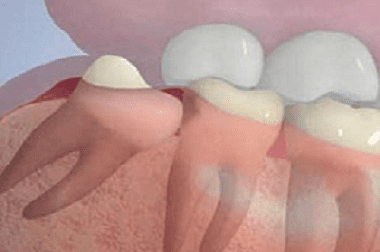Dentistry >>>> Pericoronitis - what is it?
Pericoronitis - what is it?

During the eruption of wisdom teeth (two in the upper jaw and two in the lower jaw), a complication called "pericoronitis" often occurs. Pericoronitis is an inflammation of the soft tissues (mucous and submucosal layer) in the area of the wisdom tooth being born. The inflammatory process during perekoronite is due to the traumatic position of the teething tooth and the presence of conditionally pathogenic microflora of the oral cavity, which takes the opportunity to increase its colonies.
The "hood" from the periosteum and mucous layer located above the crown part of the cutting wisdom tooth becomes inflamed, causes pain and requires intervention from the dentist - surgeon, who, with the help of an incision or excision of the "hood", will allow the wisdom tooth to "look out into the light" unhindered.
The inflammatory process in pericoronitis can take a purulent form, which is dangerous by the development of other much more complex processes - periostitis, submandibular lymphadenitis, cortical osteomyelitis. Inflammatory processes that destroy the periosteum and the alveolar process of the jaw can lead to the loss of not only the wisdom tooth itself, but also the tooth next to it or several teeth in a row. For this reason, it is important to seek medical attention in time to prevent the development of complications of pericoronitis.
Typical signss of pericoronitis:
- Pain in the area of the erupting wisdom tooth, radiating towards the ear, cheeks, temples, temporomandibular joint, making it difficult to open the mouth and chewing on the side of the erupting tooth, swallowing;
- Inflamed, hyperemic (reddened), swollen mucous membrane of the alveolar process in the area of the cutting tooth;
- Temperature increase;
- Headache and general malaise are possible;
- Submandibular lymph nodes are enlarged;
- If the process has acquired a purulent nature of the course, then when you press on the edematous mucosa, a purulent-serous fluid is released;
- Sometimes the outflow of purulent contents can be disrupted, which makes it possible for the inflammatory process to spread to neighboring tissues.
Treatment of pericoronitis depends on the severity of the inflammation and, in addition to a surgical incision, may include the installation of drains for the outflow of purulent contents, washing the gingival pocket with antiseptics and proteolytic enzymes, and taking antibiotics, if necessary, to stop the infectious process.
Sometimes the pathological eruption of a wisdom tooth forces it to be removed in order to avoid complications.
If the process of erupting a wisdom tooth is not purulent and does not cause particularly painful inconveniences, then the development of pericoronitis can be prevented by regularly rinsing the mouth from the side of the cutting wisdom tooth with antiseptic solutions for intraoral use (potassium permanganate solution, furacilin, iodinol solution) or infusions of herbal antiseptics.

Read

Read



























